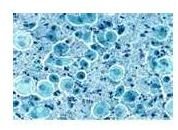Symptoms of Vaginitis: Inflammatory Types
Overview
Vaginitis is a medical condition that causes inflammation of the vagina and vulvar area. If both parts of the female genitalia are involved, it is called vulvovaginitis. Most women call any type of discomfort a yeast infection, when in fact yeast may not be the culprit. This condition is mainly caused by the unbalance of normal bacteria and/or infection from organisms such as chlamydia, Garnerella, or trichomonas. The symptoms of vaginitis vary according to which organism is causing the problem. The most common symptoms are burning, itching, and an increase of vaginal discharge, although there can be other problematic symptoms such as redness of the labia majora, labia minora, and in the perineal area (between the vagina and anus). Vaginal discharge is called leucorrhoea, which is normally clear or white. When this discharge takes on a yellowish color, becomes purulent and causes odor, an infection can be suspected.
Types of Vaginitis
Bacterial Vaginosis
This type of vaginitis is when the normal flora becomes overgrown. Some women do not know they have this vaginitis and it may be discovered during a routine gynecological exam. This overgrowth upsets the natural balance and may cause symptoms of a watery discharge with an unpleasant odor, mild irritation and/or burning of the vulva and vagina. If the discharge becomes greyish or yellowish, this means the overgrowth is heavy. BV is usually treated with an antibiotic vaginal gel.
Yeast Infection
A yeast infection is commonly caused by a fungus known as candida albicans. This organism is seen on the vulva or vagina as a thick, white discharge resembling cottage cheese. It is odorless. A yeast infection will cause burning and itching.
Trichomoniasis
This infection caused by single-cell protozoa can produce a greenish yellow, frothy type discharge. Often this discharge has a foul odor. Women complain of itching and soreness of the vaginal area and a burning sensation when urinating. This vaginitis can be transmitted through sexual intercourse, so both partners need to be treated with antibiotics for this infection to cease.
Chlamydia
Chlamydia is also a sexually transmitted form of vaginitis. Diagnosis is sometimes difficult because some women do not have symptoms. Others may notice a vaginal discharge, experience light bleeding after intercourse, and may have pain in the lower abdomen and pelvis. Chlamydia is commonly found in young women between the ages of 18-35 who have had multiple sexual partners. Women who find themselves in this category should be routinely screened for this organism. Treatment is made with antibiotics and prevention is best by using condoms.
Viral Vaginitis
Viruses can cause vaginits and the two most common types are herpes simplex virus (HSV) and the human papillomavirus (HPV). HSV is spread by sexual contact and symptoms of vaginitis in this disorder is pain associated with sores or lesions on the vulva and also inside the vagina. HPV, also know as genital warts, can erupt in the vagina, vulva, rectum, or groin. The warts range in color from white, gray to pink and purple. Some HPV warts are not visible and detection of this sexually transmitted disorder sometimes comes from a routine Pap smear.
Non-infectious Vaginitis
The symptoms of vaginitis that are non-infectious are mostly caused by allergic reactions or irritations. The common irritants come from douching, soaps, detergents, vaginal sprays, and spermicidal products. Itching, burning and discharge are the symptoms of this vaginitis with no infection. Removal of the offending agent usually clears up this vaginitis.
Atrophic Vaginitis
When women reach menopause they experience reduced estrogen, which in turn thins the vaginal lining causing vaginitis. The tissues become thinner and drier causing symptoms of itching, burning and pain. The usual treatment is vaginal estrogen replacement cream.
When plagued by any of these symptoms of vaginitis, make sure to visit your gynecologist or family physician as soon as possible for diagnosis and treatment.
References
Women’s Bodies, Women’s Wisdom by Christiane Northrup, M.D.;Bantam Books, 1998; pages 300-311
Cleveland Clinic, https://my.clevelandclinic.org/disorders/vaginitis/hic_vaginitis.aspx
MedicineNet, https://www.medicinenet.com/vaginitis/article.htm
Photo credit: American Society of Cytopathology; https://nih.techriver.net/view.php?patientid=11
